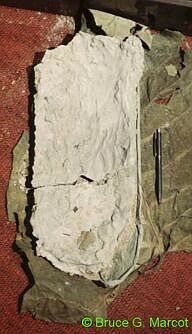Matdngdng -- The "Bigfoot" from Garo Hills, Meghalaya, Northeast India
Bruce G. Marcot
original post: 2006
last updated: 06 June 2017
The Forest Man of Northeast India -- The Mande Barung
I was told about the "forest man" -- the "bigfoot" of northeast India -- locally called Matdngdng when I was in Meghalaya, India, in April 1998 in the remote Garo Hills country, and again when I was in upper Uttar Pradesh, India, during November 1998 and back in the Garo Hills during December 2005. The term Matdngdng is a Garo Hills tribe word (yes, this is how they spelled the name). My initial field-notes write-up in 1998 was the first time I've ever seen it documented.
Here's the basis for this. I was told about this legend by a number of people in India, including:
- Shri Ajai Saxena, a research wildlife biologist with the prestigious Wildlife Institute of India in Dehra Dun, Uttar Pradesh, India
- Dr. Ashish Kumar, a wildlife researcher with the same Institute, who has been doing wildlife studies in the Garo Hills along with Mr. Saxena
- Shri Tony Marak, a Garo himself from the town of Tura in the Garo Hills
- Shri Anup Srivastava, a wildlife biologist, a Garo, and director of Balpakram National Park in the Garo Hills
Description of the Matdngdng
I queried my Garo Hills tribal friends at length on this. Here's a little composite of what they said according to stories they have been told:
- the stride is up to 1/4 mile (nope, this isn't a misprint; one field-going biologist there who strongly believes in the creature said he found one track on a riverine beach, then another 1/4 mile away, and concluded the stride from this ... an example of needing to be a bit more circumspect in drawing conclusions from limited evidence, perhaps)
- the creature is covered with long dark hair
- the creature is so tall that it has to sleep standing up, leaning against a tree (I didn't understand the logic of this either, and neither did one of my Wildlife Institute of India colleagues, but it's part of the myth).
Tracks and Interpretations
I have presented a photo I took in Garo Hills, India, of a supposed track of
Matdngdng, and my interpretation of the track, on my Bigfoot web site, starting
at:
https://www.plexuseco.com/The%20Plexus/bigf1.htm

Updates
A BBC article describes the local interest in the supposed
creature:
http://news.bbc.co.uk/2/hi/south_asia/7457894.stm
The article names the creature mande barung. In Garo language,
the phrase "mande barung" means "a wild man living in the
jungle." (My source: D.S. Nengminza, 1994, The School
Dictionary Garo to English, Eight Edition, Garo Hills Book Emporium, Tura,
India, p. 140. Yes, I've studied and used the Garo language in the Garo
Hills.)
The above linked article contains a video interview with a local Garo named James Marak, whom I had worked with on a field project in South Garo Hills in conjunction with Dr. Ashish Kumar and the Wildlife Institute of India. I found James to be a credible observer and his contribution to our field project is much appreciated.
My Indian researcher colleague, Dr. Ashish Kumar, had conducted much field research in the remote parts of Garo Hills of western Meghalaya state, northeast India, the supposed abode of Matdngdng (or Mande Barung). Dr. Kumar had this very interesting insight to offer:
At that time, it was concluded that foot prints and other signs of presence
of Yeti were made by terrorists in order to keep villagers and local
people away from their hides inside the forest area.
His recent updates from northeast India purport to have encountered odd
tracks in a location about 20-25 km from the city of Baghmara of South Garo
Hills, Meghalaya, toward the southern Nokrek Ridge area where I have studied
native wet evergreen forests and their biodiversity, and toward the city of Tura
where I have stayed during my explorations of the region. (For my
studies and publications in India, including this region, see: https://www.plexuseco.com/The%20Plexus/links_india.htm).
According to his report, he and fellow observers -- including a principal of a local primary school, and a Range Forest Officer and other frontline staff from Balpakram National Park Division of Baghmara -- found a large footprint some 18-20 inches long, and discovered some pole-size trees trampled by what they presumed was the Mande Barung or Jungle Man. They followed the tracks for a kilometer in the jungle. The nearest footprint was reported to be about half a kilometer from the village center. The distance between prints was at least 15 feet, and thus the height of the creature was presumed to be around 25-30 feet. However, their conclusion was that forests of Garo Hills are not capable of hiding a family of such a giant creature, particularly in the area reported as it was near the large city of Tura to the west of Nokrek Ridge.
[At this point in their reports, I cannot but consider the similarity of such evidence to tracks and sign of Asian elephants, which are relatively common in the back woods of South Garo Hills. Although I'm sure that my Indian and Garo colleagues would agree on this point, but also that we should still keep an open mind to possibilities.
And, yes, I have conducted scientific research on Asian elephants in the Garo Hills; see the above link for
my publications on this topic.]
A number of stories about the Mande Barung have been relayed from Garo villagers, including James Marak (noted above), although Dr. Kumar and I have not yet encountered any persons who have actually seen the giant creature. Instead, such stories may have been promulgated to keep innocent villagers away from the forest hiding places of terrorists (noted in his quote, above).